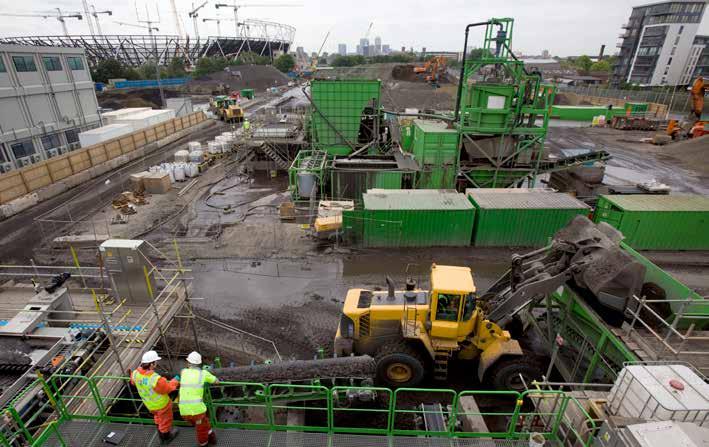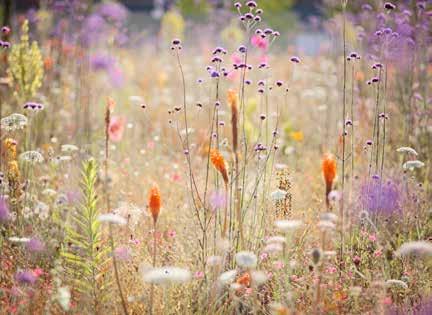
6 minute read
Scratching the surface – soil remediation in Queen Elizabeth Olympic Park
As developments accelerate around the Park, the project’s head of landscape Ruth Holmes explains why getting the soil right for 2012 has left an important legacy
By Ruth Holmes

Aerial photograph of Queen Elizabeth Olympic Park 2019 – 7 years on since the 2012 Olympic and Paralympic Games showing the establishment of the landscape and the iconic venues
© LLDC
From the sky, Queen Elizabeth Olympic Park can be seen with its blanket of green and gold divided by ribbons of blue and grey, the setting for the ‘greatest show on earth 1 ’. So much has been written about the Park and the legacy of the 2012 Olympic and Paralympic Games, yet the story goes much deeper when you scratch the surface.
The site was previously heavily polluted following a century of industrial use. A challenge central to the 2012 vision was to provide a significantly improved soil base to the Olympic Park (now Queen Elizabeth Olympic Park) as a starting point for the planting that would define the 2012 Games, as well as inspire a green legacy beyond. At an early stage in the planning, crucial land reclamation decisions were made to include a complex and arduous process of soil washing, decontamination and production which would take years to complete. The site soils contained potential chemical contaminants (such as heavy metals, hydrocarbons, asbestos), physical contaminants (glass, nails) and biological contaminants (Japanese Knotweed) which needed to be extracted through mobile remedial technology.
The alternative of removing and replacing the soil would have been costly and contrary to the spirit of the 2012 Games and the regeneration of the site. The technical detail presented in the Olympic Soil Strategy 2 written by Tim O’Hare was, at the time, revolutionary. It made the case for the benefits of good soil design as an integrated part of the design process, highlighting the socio-economic and environmental value.
The project to transform this part of London had backing from the UK Government and from the Mayor of London to make it a highly sustainable endeavour. Visitors today enjoy this 21st century landscape, welcoming everyone with porous boundaries and accessible routes through an undulating landscape. The soils not only support planting and habitat, but also perform biological functions through fungal and bacterial activity; environmental interaction through gaseous exchange and carbon sequestration; water attenuation and filtration; offer a platform for construction; protection of buried cultural heritage and facilitate food production. The parklands were designed to be accessible and welcoming with a great deal of work to engineer the landforms, lawns, meadows, planting and vistas.

One of the two soil hospitals which formed part of the enabling works, processing tonnes of contaminated soil to be reused on site to create the landforms and remediating the ground for future land uses
© LLDC
Seven years on since the Games, visitors who enjoy the Park have an experience that is based on the soils that were created from “soil hospitals” from 2007 to 2010. The use of the term ‘soil hospital 3 ’ is powerful, as it reflects the sense of crisis and distress of what had been done to the soil in the area. The industrial processes, rail and waterway transportation had left the soil diseased and contaminated. This needed to be treated using technical expertise to restore and heal a landscape, creating something new, viable and vital. The soil hospitals treated 100,000s of tonnes of soil using soil washing, bioremediation and stabilisation/solidification technology to meet the immovable deadline.
The soil washing process utilised the difference in grain sizes and density of the materials to separate the different particles by means of screens, hydrocyclones and upstream classification. This enabled the removal of the fine particles that the contaminants adhered to, into a filter-cake residue, thus minimising contaminated soil that needed to be disposed off-site.
Clever soil chemistry or Thermal Desorption helped extract the pollutants by heating the soil to the point where the contaminating compounds vaporise and the resulting gases removed. The treated soil then created the landforms with a manufactured top layer that could support the planting and habitat. This ‘cover system’ isolated the contamination from site operatives, end-users and the wider environment to form a ‘Human Health Layer’ which is indicated with marker layer of orange mesh. A manufactured 450mm layer of soil covers the Park (deeper in areas with trees) to sustain an array of different species. These carefully-blended soil mixes of mineral and organic components, create the displays and ecological areas.

The top layer of on-site manufactured soils being laid with the orange mesh marker layer to indicated the remediated soil beneath
© Tim O’Hare
The neighbourhoods and areas under development benefit from the remediated soil designed for a range of land uses. Schemes must now work within carefully defined parameters to avoid creating pollutant links to the site and this can include the introduction of more sensitive end uses. Each new development must consider how it will accommodate piercing through the marker layer to the treated layer beneath, which is suitable for landform but not as a growing medium due to the residual contamination. Operations range from planting another tree through to setting down foundations for buildings or structures.
So, what are the continuing challenges? Species rich lawns were created on soil that was designed to drain within 30 minutes of a heavy downpour. We are now treating this soil to improve its water retention in light of the hotter, drier climatic conditions London is now facing. Trees that have structural soil that can cope with the heavy footfall are managed to achieve a good balance of water, nutrients and mycorrhiza to keep the trees in good health.
The lower-nutrient soils planting such as the Fantasticology meadow continue to be incredibly successful. Fantasticology is possibly one of the largest colour segregated meadows in the UK. Not only is it still visibly the artwork that was created for the time of the 2012 Games, but it is also alive with invertebrates and we hope that it will become part of the UCL East site, part of an academic living landscape laboratory. Park management is minimal but carefully planned, to maximise the floriferous impact and biodiversity.

The meadows on Queen Elizabeth Olympic Park are designed to be high impact, low intervention. This is only possible due to the species selection and soil constituents being designed together to reach optimum conditions for the visual effect and biological function
© Nigel Dunnett
The species choice combined with the soil design has created meadows that flow down to the water’s edge, with the London Stadium as their backdrop. Not far from the Park, experiments with soils are being pioneered by John Little in community gardens in Clapton Park Estate 5 which, in collaboration with UCL, could advance sustainable and economic practices researched by landscape students.
The soils have also supported temporary ‘Stitch’ landscapes, so called because they stitch the Park into the developments along its edges. The planting has surrounded the hoardings of the development plots across the site. Nigel Dunnett’s planting scheme has kept the Park vibrant and delightful with the nutrient poor, steppe-like conditions helping the wide diversity of plant species to thrive with less maintenance. This has achieved displays that have long seasonal interest and which change dynamically throughout the year. The transformation of the site above ground has only been possible due to the transformation below the surface.
The nine different soil types designed by soil consultants 6 provide for many future land uses. These manufactured soils were carefully constructed from the most sustainable materials with meticulous monitoring and inspection of the soil handling and management. The experts involved in the creation of the Park continue to spread and develop the technical know-how based on the highprofile nature of Queen Elizabeth Olympic Park. This put soil remediation operations in the spotlight as part of the ‘most sustainable Games’.
The lessons learned have been transferred to many other projects and will hopefully inspire more focus on responsible soil management and designed soil creation in the future. The Park continues to welcome people who want gain insight to tackle the significant issues facing soils and the landscapes across the world.
Ruth Holmes is a landscape architect and Head of Landscape for Queen Elizabeth Olympic Park.










